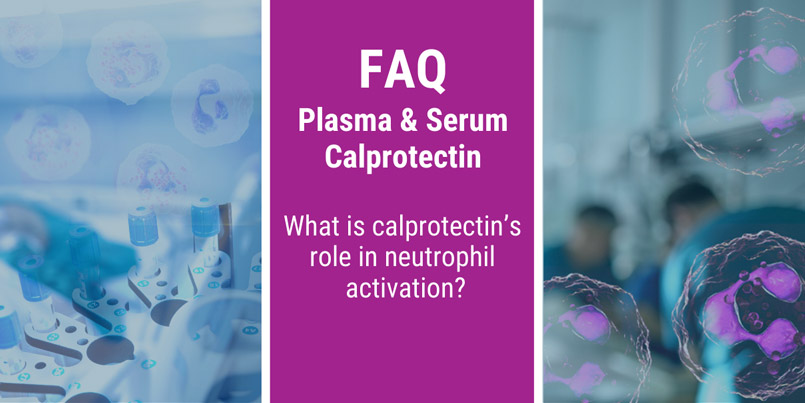
In our Frequently Asked Questions about calprotectin series we will answer questions we often receive about plasma and serum calprotectin and the Gentian Calprotectin Immunoassay GCAL®. If you have any additional questions don't hesitate to contact us on marketing@gentian.com.
In this section we will look into what role calprotectin play in neutrophil activation.
Calprotectin is a S100 protein
Calprotectin is a heterodimer of two calcium-binding proteins and belongs to the S100 protein family (Synonyms: S100A8/A9 or MRP8/14). It is released from activated and consumed immunocytes, such as neutrophils, monocytes and macrophages1-5 during inflammation and upon bacterial infection. Calprotectin is well known extracellular alarmin or damage associated molecular pattern (DAMP) protein. It exerts its pro-inflammatory activity via receptors such as RAGE and TLR4, and NF-kB and p38 activation1,3,5.
Calprotectin also has anti-microbial activity by the binding of zinc and manganese, which leads to so-called nutritional immunity by ‘’starving’’ the bacteria1,5,6.
What is NET (neutrophil extracellular traps)?
Neutrophils are the dominant leukocytes circulating the blood, and they are the first innate immune cells that are recruited to a site of infection. Here the neutrophils have several defence strategies, including the production of toxic reactive oxygen species (ROS), the release of anti-microbial factors and the formation of neutrophil extracellular traps (NET).
The NETs are composed of a mesh-like structure which consists of DNA strands, histones and antimicrobial proteins. They can therefore ensnare the microbes by localising and trapping pathogens within the sticky meshwork of chromatin, and also expose them to the highly concentrated anti-microbial factors6.
Calprotectin is one of most abundant proteins in the cytosol of neutrophils making up around 40 %-60% of the cytosolic proteins. Calprotectin is released from the neutrophils during inflammation, executing its pro-inflammatory function as alarmin, and is part of the anti-microbial factors in the NETs1,6,7. Both the calprotectin release and the neutrophil activation are regulated in negative-feedback loops. However, uncontrolled expression of calprotectin will also accelerate the neutrophil activation and trigger release of further pro-inflammatory factors leading, to inflammatory damage and septic shock1.
Neutrophils and calprotectin:
- Neutrophils are major players in first-line defence against infection
- Calprotectin is released from neutrophils and acts as anti-microbial factor and pro-inflammatory alarmin
- Calprotectin is upregulated in infections and inflammatory conditions and a promising biomarker for neutrophil activation and inflammation
- Calprotectin correlates with disease activity in multiple inflammatory conditions, both in infectious and non-infectious inflammatory conditions
Calprotectin – the promising early biomarker of neutrophil activation
Since calprotectin is released by activated neutrophils in inflammation in several infectious and non-infectious conditions, calprotectin is a promising biomarker for neutrophil activation and inflammatory conditions where it also correlates well with disease activity, including bacterial infections, sepsis and autoimmune inflammatory conditions, like rheumatoid arthritis1-4.
GCAL® – Gentian’s Calprotectin Immunoassay
- Particle-Enhanced Turbidimetric Immunoassay (PETIA)
- Serum and plasma samples
- Rapidly performed in only 10 minutes
- Can be applied on a wide range of automated clinical chemistry analysers
- Avian antibodies – less interference with RF and HAMA
- CE-marked
Get in touch
For more details about the Gentian Calprotectin Immunoassay GCAL® please contact us at marketing@gentian.com or fill out the form below:
FAQ about plasma and serum calprotectin
What type of assay is the Gentian Calprotectin Immunoassay GCAL®?
What is the clinical value of calprotectin in sepsis & severe infections?
Is calprotectin upregulated in sepsis in COVID-19?
What role can plasma & serum calprotectin play in severe COVID-19?
How is calprotectin useful to monitor treatment response in rheumatoid arthritis?
How is calprotectin useful in clinical assessment of rheumatoid arthritis?
References:
- Wang S et a. S100A8/A9 in Inflammation. Front Immunol. 2018.
- Stríz I, Trebichavský I. Calprotectin - a pleiotropic molecule in acute and chronic inflammation. Physiol Res. 2004.
- Pruenster M et al. S100A8/A9: From basic science to clinical application. Pharmacol Ther. 2016.
- Chan JK et al. Alarmins: awaiting a clinical response. J Clin Invest. 2012.
- Zackular JP et al. Nutritional Immunity: S100 Proteins at the Host-Pathogen Interface. J Biol Chem. 2015.
- Teng TS et al. Neutrophils and Immunity: From Bactericidal Action to Being Conquered. J Immunol Res. 2017.
- Urban CF et al. Neutrophil extracellular traps contain calprotectin, a cytosolic protein complex involved in host defense against Candida albicans. PLoS Pathog. 2009.


.jpg)
.jpg)